You’ll find Red Rock State Park just west of Sedona, and getting there is easy whether you drive, bike, or take a shuttle. Plan for golden light, quiet trails, and viewpoints that make the red cliffs glow — but knowing when to go, where to park, and which paths match your energy level will make the trip smoother. Keep going to learn the best routes, top hikes for every ability, and practical tips that’ll improve the whole day.
Getting There: Directions, Parking & Transportation Options

When you head to Red Rock State Park, plan your route before you leave: the park sits about 10 minutes west of Sedona off Highway 89A, and signs for the park and volunteer-hosted visitor center are easy to follow. You’ll find a paved parking lot near the trailheads with ample space, but popular weekends fill early, so arrive mid-morning or later in the afternoon. If you’re avoiding driving, check local public transport and shuttle services that connect Sedona to nearby trailheads; schedules vary seasonally. For drivers, use the scenic driving routes that skirt Oak Creek Canyon and watch for pullouts if you want quick photo stops. Carry water, a paper map or offline GPS, and park pass payment—you’ll save time and stay flexible.
Best Times to Visit: Weather, Seasons & Crowd Tips
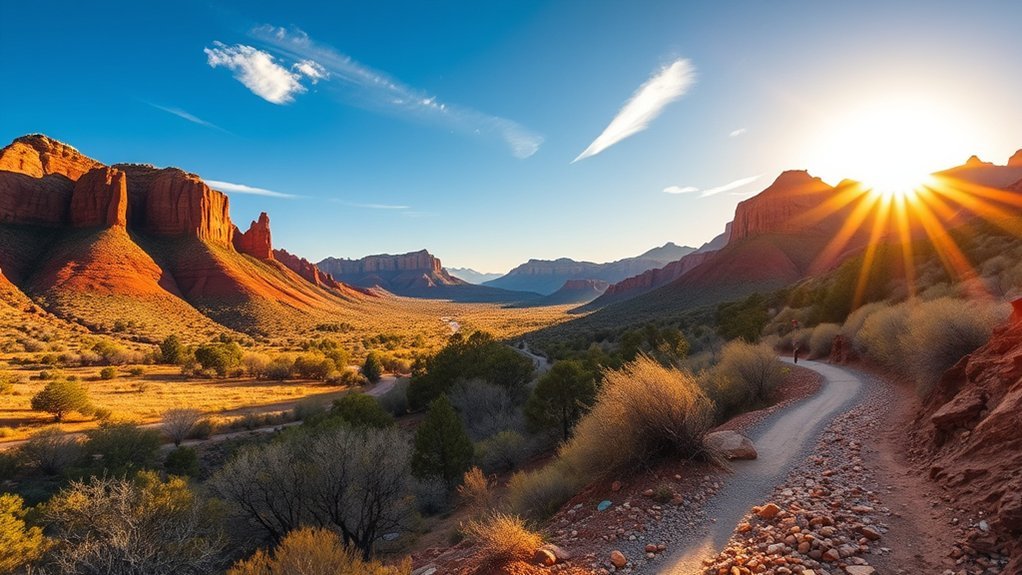
Seasons shape everything at Red Rock State Park, so pick the time that matches what you want to see and do: spring (March–May) brings wildflowers and mild temperatures ideal for hiking, summer gets hot by mid-day but offers verdant canyon walls after monsoon storms, fall (September–November) gives crisp air and dramatic light that photographers love, and winter is quieter with cooler trails and occasional frost on the red rocks. For best weather and lighter seasonal crowds, aim for late March–May or mid-October, when mornings are pleasant and afternoons comfortable. Weekdays and early mornings beat weekend peaks; arrive before 9 a.m. in summer to avoid heat and high crowds. Pack layers, sun protection, and water—conditions change fast between canyon shade and exposed mesas.
Top Trails & Hikes for All Abilities
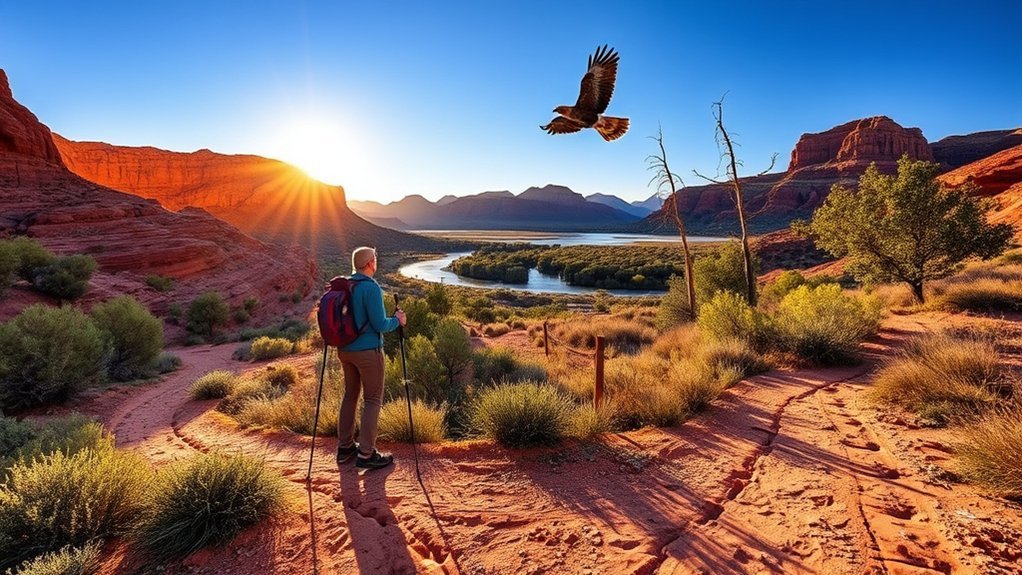
You’ll find trails for every mood and fitness level, from gentle creekside loops where the water and birds set a slow, restorative pace. Push a bit farther onto red-rock ridges for sweeping views and moderate climbs that reward you with sunlit spires. If you’re up for a real challenge, canyon scrambles test your balance and stamina while exposing you to hidden alcoves and dramatic cliffs.
Easy Creekside Loops
A handful of gentle loops follow the creek through red-rock shadows and fragrant riparian brush, so you can soak in the scenery without tackling steep climbs. You’ll find well-marked paths that hug the water, making it easy to navigate with kids or a stroller. Look close at the creekside flora — willows, cottonwoods and wildflowers — and listen for birds that frequent the shade. Benches and short spur trails open to unexpected scenic vistas across the river-channel and sandstone fins, perfect for a picnic or photos. Trails are mostly compacted dirt with occasional roots; wear sturdy shoes and bring water. Pace yourself, rest often, and you’ll leave feeling refreshed, connected to the park’s quieter side.
Moderate Red-Rock Ridges
While the creekside loops soothe, the moderate red‑rock ridges invite you to climb where mesas and fins shape panoramic views and steady heartbeats, offering a bit more challenge without demanding technical gear. You’ll tackle moderate terrain: packed dirt, occasional slickrock, and short steeper pitches that reward steady pacing. Choose trails with switchbacks to reduce strain, bring trekking poles if you want extra balance, and wear shoes with good traction. Along the ridgelines, pause at scenic overlooks to drink in layered buttes, distant pines, and the valley below — perfect spots for photos or a quiet snack. Watch the weather, carry water, and plan hikes for cooler morning or late‑afternoon light to maximize comfort and color.
Challenging Canyon Scrambles
When you’re ready to push beyond ridgelines, the canyon scrambles call for hands, feet, and careful route‑finding as narrow slots, bouldered gullies, and steep ledges demand more focus and grit. You’ll move deliberately, testing holds and choosing lines that conserve energy while avoiding loose rock. Learn basic canyon navigation techniques—reading contours, spotting cairns, and backtracking when signals fade—to keep oriented in tight terrain. Pack safety gear essentials: helmet, sturdy shoes with sticky rubber, gloves, a compact first‑aid kit, and extra water. Go with a partner, tell someone your plan, and set turnaround times. Scrambles reward you with hidden alcoves, dramatic light shafts, and a sense of earned solitude; respect the route and your limits to enjoy them fully.
Wildlife, Birdwatching & Plant Life to Look For
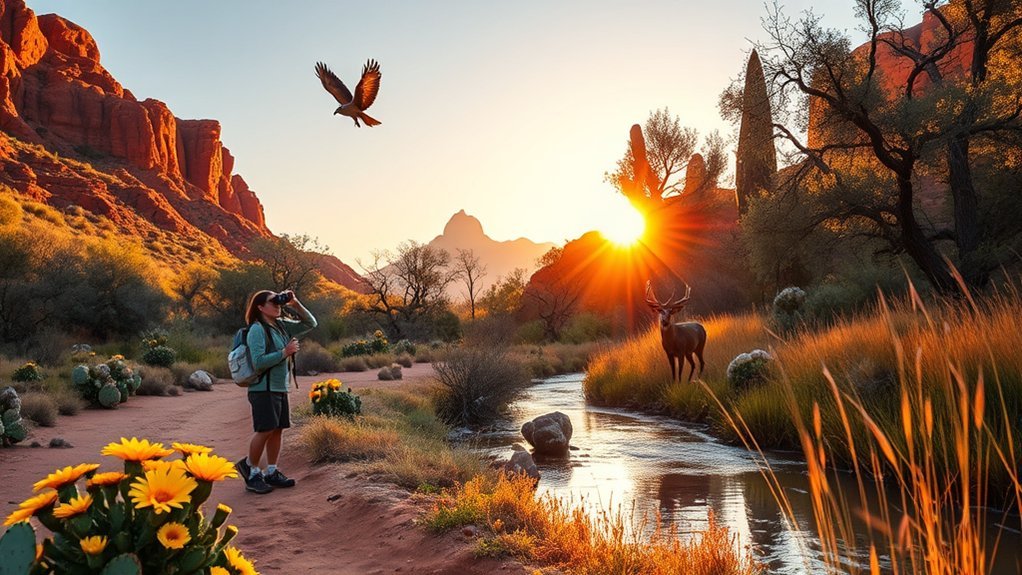
As you walk the trails you’ll likely spot mule deer, coyotes and other small mammals moving through the juniper and oak. Bring binoculars for year‑round birdwatching—look for raptors on cliffs in winter, migratory songbirds in spring, and waterfowl along Oak Creek. Keep an eye on the ground and slopes for native grasses, prickly pear, and bright wildflowers that color the season.
Common Mammals to Spot
You’ll likely spot several familiar mammals during a visit to Red Rock State Park, especially in the cooler hours of dawn and dusk when animals are most active. You may see mule deer grazing on riparian edges, coyotes slipping along washes, and rock squirrels darting among boulders. Knowing basic mammal species and common wildlife behavior helps you recognize tracks, scat, and feeding signs without disturbing animals. Keep quiet, use binoculars, and watch from trails or overlooks to catch a fox pausing on a ridge or a bobcat slipping into brush. Small mammals—packrats, rabbits, and bats at dusk—offer quick flashes of movement. Respect distance, secure food, and let these encounters remain wild for both your safety and theirs.
Birds for Every Season
Because birdlife changes with the seasons, you’ll find new species and behaviors on every visit to Red Rock State Park, making it worth timing your trip to match your interests. In spring and fall, seasonal birdwatching is thrilling as warblers, vireos and thrushes ride migratory patterns through the riparian corridors; bring binoculars and a field guide to catch quick, colorful glimpses. Summer fills the canyons with breeding songbirds and raptors—listen for nesting calls and scan cliffs for hawks. In winter you’ll spot resident scrubjays, towhees and hardy waterfowl along cooled streams. Walk early, stay quiet, and use trails that follow the creek for the best viewing. Note behavior, habitat and light conditions to refine future visits.
Native Plants & Wildflowers
When you wander the trails of Red Rock State Park, native plants and wildflowers create a living map of the seasons — bright penstemon and Indian paintbrush splash the mesas in spring, claret cup and prickly pear bloom under high summer sun, and golden rabbitbrush and sagebrush bring texture to the cooler months. You’ll learn which native species anchor each habitat and how blooming seasons shift with elevation and rainfall. Stay on trails, photograph, don’t pick — seeds feed wildlife and preserve views. Look for pollinators near clustered blossoms and check shady washes for delicate ferns after rains.
- Spring: penstemon, Indian paintbrush — best for color photos.
- Summer: claret cup, prickly pear — drought-tolerant displays.
- Fall: rabbitbrush, sagebrush — subtle tones.
- Year-round: cottonwood stands by creeks.
Activities Beyond Hiking: Tours, Photography & Picnicking
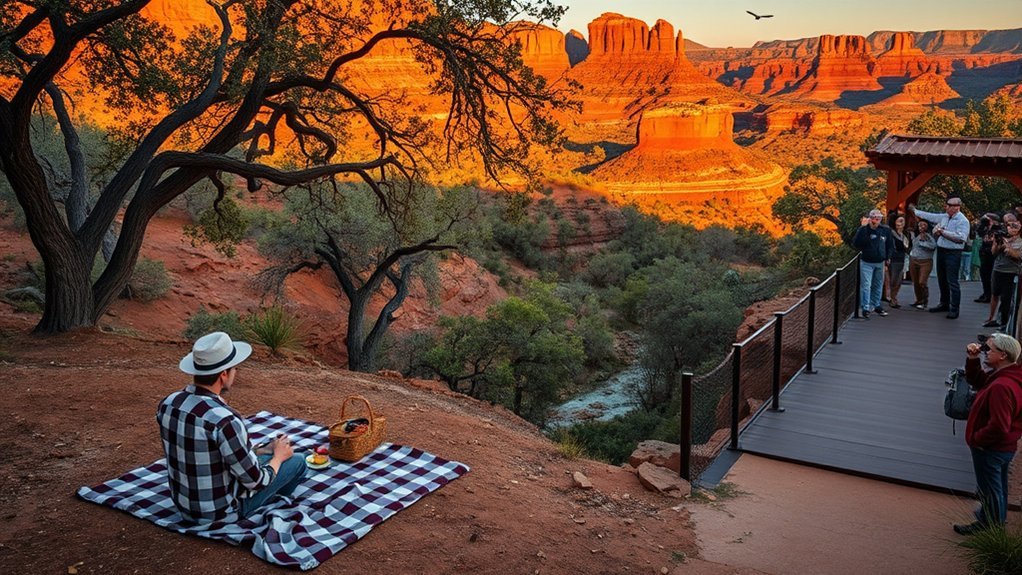
Although trails are the park’s backbone, tours, photography spots, and picnic areas offer ways to slow down and soak in the landscape from different angles. You can join guided nature walks to learn geology and birdlife — guides point out hidden viewpoints and seasonal highlights so you won’t miss prime framing opportunities. For photography tips, shoot golden hour light, use a polarizer to deepen skies, and include foreground rocks for scale. Several picnic spots sit near creeks and red-rock outlooks; pick a shady table for midday respite or a rimside spot at sunset for dramatic color. Bring a small blanket, pack out trash, and let quiet moments between hikes become the centerpiece of your visit.
Practical Tips: Fees, Facilities, Safety & Accessibility
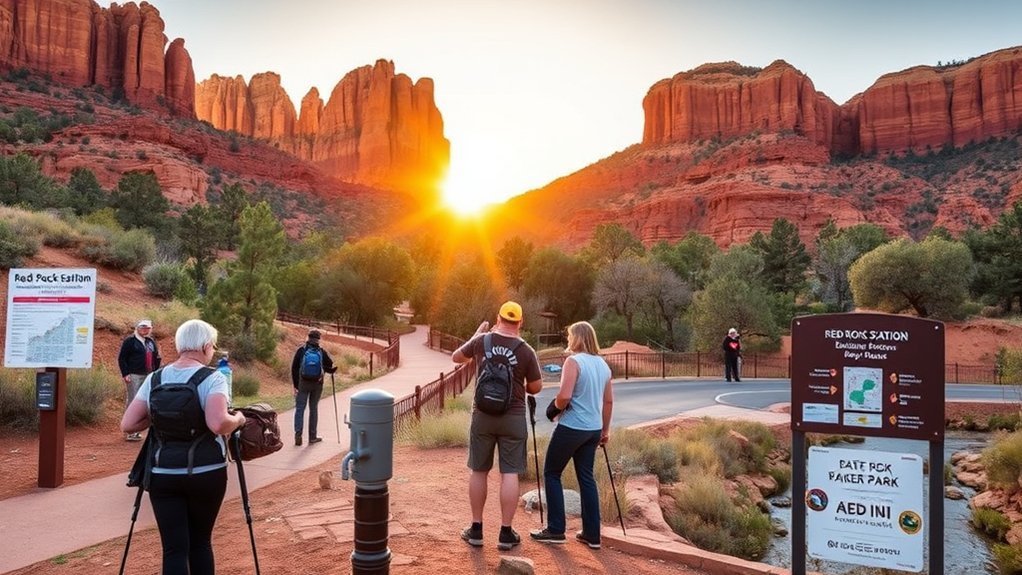
If you’re planning your visit, know the basics up front so nothing surprises you: the park charges a modest entry fee collected at the ranger station, restrooms and water fill stations sit near the trailheads, and picnic areas offer shade but limited trash service, so pack out anything you bring in. You’ll want sturdy shoes, sun protection, and a refillable bottle — temperatures swing and trails are rocky. Staff can advise on conditions; watch for flash floods in monsoon season. Accessibility is good for short loops and the visitor center, but some overlooks require uneven terrain. For safety, tell someone your route and carry a map, phone, and basic first-aid kit.
- Check current entry fees and hours.
- Use restroom facilities before long hikes.
- Respect wildlife and stay on trails.
- Prepare for sun and changing weather.
Frequently Asked Questions
Are Dogs Allowed on Trails or in the Visitor Center?
Yes — you can bring dogs on designated trails and in picnic areas, but not inside the visitor center; follow park regulations, keep pets leashed, clean up waste, and enjoy the dog friendly areas while respecting wildlife and other hikers.
Are Drones Permitted Within Park Boundaries?
No — drones aren’t allowed; you’ll follow drone regulations, respect photography guidelines, avoid disturbing wildlife, and preserve quiet. Bring cameras, hike thoughtfully, plan legal alternatives, and capture scenery without flying or endangering park habitats.
Can I Camp Overnight Inside Red Rock State Park?
No, you can’t camp overnight inside Red Rock State Park; camping regulations restrict overnight stays. You’ll find nearby campgrounds with camping amenities like restrooms, potable water, picnic tables, shaded sites and guided-ranger programs for safety.
Is There Cellular Service or Wi‑Fi in the Park?
About 60% of the park has spotty reception; you won’t rely on steady cellular coverage or park wi‑fi. Bring offline maps, download guides beforehand, and enjoy unplugged trails while using limited internet access for emergencies only.
Are Guided Stargazing or Night Programs Offered?
Yes — you’ll find occasional stargazing events and guided night hikes led by rangers; they’re practical, evocative experiences, so bring layers, a flashlight with red filter, and arrive early to learn constellations and nocturnal life.
Conclusion
Think of Red Rock State Park as a well-loved book: open it, and every trail is a chapter, each vista a vivid paragraph. You’ll arrive easily, wander through pages of cactus, juniper and sky, and pause at picnic spots like bookmarked scenes. Time your visit for softer light and fewer readers, pack water and a camera, and tread kindly—this is a shared story. Close the cover, but know you’ll want to return.

